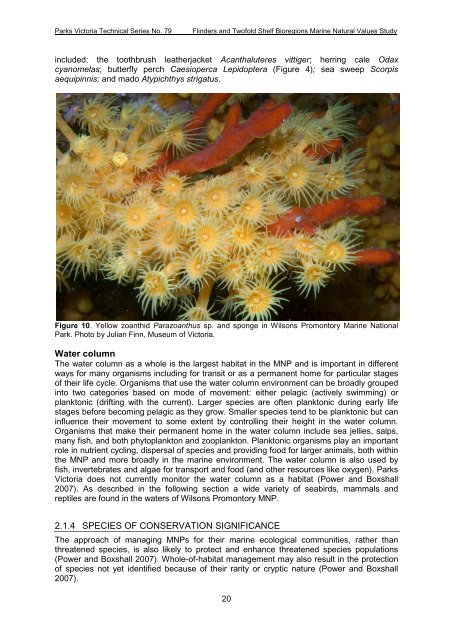parks victoria technical series marine natural values study vol 2 ...
parks victoria technical series marine natural values study vol 2 ...
parks victoria technical series marine natural values study vol 2 ...
Create successful ePaper yourself
Turn your PDF publications into a flip-book with our unique Google optimized e-Paper software.
Parks Victoria Technical Series No. 79<br />
Flinders and Twofold Shelf Bioregions Marine Natural Values Study<br />
included: the toothbrush leatherjacket Acanthaluteres vittiger; herring cale Odax<br />
cyanomelas; butterfly perch Caesioperca Lepidoptera (Figure 4); sea sweep Scorpis<br />
aequipinnis; and mado Atypichthys strigatus.<br />
Figure 10. Yellow zoanthid Parazoanthus sp. and sponge in Wilsons Promontory Marine National<br />
Park. Photo by Julian Finn, Museum of Victoria.<br />
Water column<br />
The water column as a whole is the largest habitat in the MNP and is important in different<br />
ways for many organisms including for transit or as a permanent home for particular stages<br />
of their life cycle. Organisms that use the water column environment can be broadly grouped<br />
into two categories based on mode of movement: either pelagic (actively swimming) or<br />
planktonic (drifting with the current). Larger species are often planktonic during early life<br />
stages before becoming pelagic as they grow. Smaller species tend to be planktonic but can<br />
influence their movement to some extent by controlling their height in the water column.<br />
Organisms that make their permanent home in the water column include sea jellies, salps,<br />
many fish, and both phytoplankton and zooplankton. Planktonic organisms play an important<br />
role in nutrient cycling, dispersal of species and providing food for larger animals, both within<br />
the MNP and more broadly in the <strong>marine</strong> environment. The water column is also used by<br />
fish, invertebrates and algae for transport and food (and other resources like oxygen). Parks<br />
Victoria does not currently monitor the water column as a habitat (Power and Boxshall<br />
2007). As described in the following section a wide variety of seabirds, mammals and<br />
reptiles are found in the waters of Wilsons Promontory MNP.<br />
2.1.4 SPECIES OF CONSERVATION SIGNIFICANCE<br />
The approach of managing MNPs for their <strong>marine</strong> ecological communities, rather than<br />
threatened species, is also likely to protect and enhance threatened species populations<br />
(Power and Boxshall 2007). Whole-of-habitat management may also result in the protection<br />
of species not yet identified because of their rarity or cryptic nature (Power and Boxshall<br />
2007).<br />
20

















